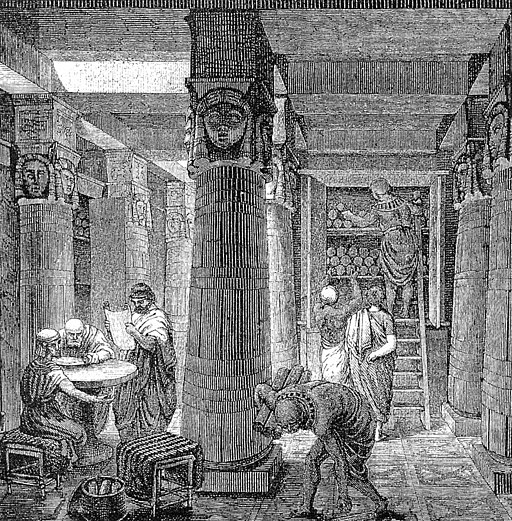This week I thought I would share with you one of the first known women mathematicians as part of the Multicultural Kid Blogs' Women's History Month Series and my Multicultural Mathematics. Be sure to visit the main page of the Women's History Month Series to see all of the posts and link up your own!
 |
| By Drawn by Jules Maurice Gaspard (1862–1919) [Public domain], via Wikimedia Commons |
 |
| The Great Library of Alexandria By O. Von Corven [Public domain], via Wikimedia Commons |
 |
| Hypatia By Alfred Seifert (1850-1901) (Bonhams) [Public domain], via Wikimedia Commons |
 |
| Duk at the English language Wikipedia [GFDL or CC-BY-SA-3.0], from Wikimedia Commons |
Conic sections are the shapes one gets from cutting a double-napped cone by various planes. As seen in the illustration above four shapes are possible: parabola, circle, ellipse and hyperbola. Often in Algebra 2 or Precalculus conic sections are studied with their equations and then applied to real life. I always found it useful to give students a note outline for all four conic sections which can be useful when studying for the exam and trying to learn the equations and characteristics. The note page and its answer page are available for personal or classroom use. Please do not publish it on your own site, but send people here to get theirs. For more on conic sections check out, NCTM (National Council of Teachers of Mathematics), Cool Math and She Loves Math. For some examples of real life applications check out: Stack Exchange, Purple Math, Jim Britton's Website, Prezi Presentation, Prezi Presentation 2, and Boundless.
 |
| The Murder of Hypatia, See page for author [Public domain], via Wikimedia Commons |
Sources for this post:
- Wikipedia
- Redshift
- Donovan, Sandy. Hypatia: Mathematician, Inventor, and Philosopher, Compass Point Press 1967.
- Bradley, Michael J. Ph.D., The Birth of Mathematics: Ancient times to 1300, Chelsea House Publishers 2006.
Now to introduce Hypatia to Hazel (who is six), I found a picture book. I was very happy to be able to read a book to Hazel about a female mathematician. Unfortunately there are not too many around about any of the others. We read Of Numbers and Stars: The Story of Hypatia by D. Anne Love and illustrated by Pam Paparone. We borrowed it from our library. This book gave a brief introduction to Hypatia with much of the story romanticized for young children. It was a good introduction and I am just happy there is a picture book out there about a female mathematician.
For older students there is Hypatia: Mathematician, Inventor, and Philosopher by Sandy Donovan. I borrowed this book from the library as well. It is from the Young Adult section and is written in chapters. It is part of the Signature Lives series. I also used it as a source for my post. Other books that can be used for information on Hypatia as well as other female mathematicians that I found at our library are the following.
For more Multicultural Math and Women's History Posts check out:
- Benjamin Banneker
- Mahalia Jackson
- Books for Women's History Month Round-Up
- Sara Josepha Hale
- Princess Grace





